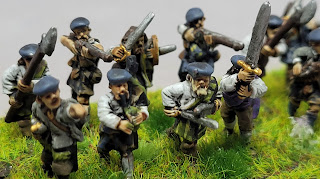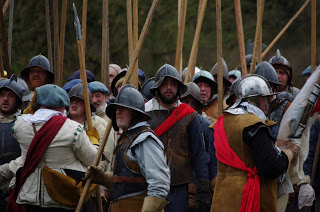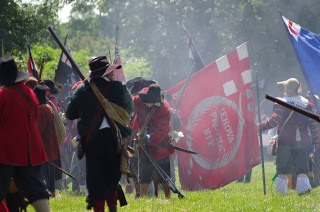Houses of Interest: Lothian
The inappropriately named ECWtravelogue turns its attention to Lothian, scene of Oliver Cromwell's arguably greatest military victory.
See also Edinburgh
Before we turn our attention to the Second Battle of Dunbar, there are a couple of other Wars of the Three Kingdoms locations worthy of our attention..jfif) |
| Borthwick Castle's cannon scars |
Borthwick Castle, was besieged by Oliver Cromwell's forces in November 1650; the garrison, short on supplies, surrendered after receiving only a handful of cannon shots. The damage to the walls from this attack is still visible. Borthwick is now a wedding venue.
Dirleton Castle: post-Dunbar the castle held out and moss troopers from the castle made a considerable nuisance of themselves. So much so, that Cromwell ordered Monck and Lambert to take the castle, with 1600 men. The castle would fall due to a combination of starvation and mortar fire (destroying the drawbridge and inner gate) on the 10th November 1650. A number of the moss troopers would be hung from the castle walls. A brief existence as a field hospital, before being slighted by order of Parliament.
 |
| Dirleton Castle |
In the 1640s five women, and one man were tried as witches in the Great Hall, before being executed by strangulation. The Scottish First Minister, would officially apologise for the persecution of alleged witches during the 16th, 17th, and 18th centuries in March 2022.
Dirleton is cared for by Historic Environment Scotland, so expect expensive fudge tablet* and shortbread biscuits in the shop.
 |
| Hailes Castle, courtesy East Lothian Courier |
Hailes Castle was slighted after Dunbar. Due to the perilous condition of the masonry, there is strictly no public access to the site.
Finally we turn to Dunbar, which has such a bearing upon so many events that happened in 1650-1.
 |
| The Dunbar memorial |
But first we need to do the wibbly go-back-in-time screen effect.
1649, Charles I is executed, the Scottish Parliament has not been consulted (remember Charles is King of Scotland as well as King of England, and they are most definitely not the same thing). The Westminster Parliament declares a Commonwealth, Scotland's Parliament however, declares Charles, Prince of Wales the new king. Before allowing him to return from exile the Dutch Republic to reclaim his crown, they required him to first sign both Covenants acknowledging the authority of the Kirk in religious affairs and that of Parliament in civil matters. Charles II reluctantly agrees and signs the Treaty of Breda, effectively kickstarting the Anglo-Scottish War and the Third Civil War.
Fast forward to 1650 and Cromwell and the New Model Army invade Scotland, with an eye on initially taking Edinburgh.
The NMA crossed into Scotland on 22nd July, with a strength of over 16,000 men. The Scots withdrew to Edinburgh, stripping the land of provisions. Cromwell attempted to draw the Scots out into a set piece battle, but they resisted, and Cromwell was unable to break through their defensive line. At the end of August, with the NMA weakened through disease and malnutrition, Cromwell withdrew to the port of Dunbar. The Scots followed and took up a position on Doon Hill, overlooking the town. On 2nd September, the Scots moved off Doon Hill towards Dunbar town and the English took up positions outside the town.
 |
| the other information panel at the battle memorial |
Before dawn on 3rd September the English launched a surprise attack on the Scots, who were poorly prepared, despite having a considerable numerical advantage over the NMA. Both sides lined up roughly on an east-west axis, the NMA with their backs to Dunbar town in the north, the Scots to the south.
Lambert and Lilburne's NMA cavalry were positioned roughly where the modern A1087 passes Broxmouth Park. The majority of the Scots cavalry faced them. The NMA artillery park positioned on the banks of Spott Burn, with infantry behind them. Okey's dragoons were in and around Spott towards Doon Ford, where a small force of Scots cavalry opposed them.
At 4am the NMA advanced, clearing Scottish pickets and both side's artillery started their bombardment.
By 5am Lambert's horse were in amongst the Scottish camp, with Monck's infantry following on behind. Lilburne and Pride's horse remaining in reserve. Montgomerie's Scottish horse fled in disarray from Lambert, but Strachan and Douglas's horse would prove stiffer opposition causing Lambert and Monck's men to be in disarray.
 |
| Dunbar Quarry - location of the cavalry action |
Lilburne's horse would outflank Strachan and Douglas's horse who would be routed from the field. Pride's horse would plug the gap vacated by Monck's infantry causing Lawer's foot to rout. The NMA horse would continue their charge right through the flank of the Scottish lines. The battle was over by breakfast.
The Scots would lose about 500 men, a further 100 wounded, and 5-6000 captured. The NMA would lose less than 50 men, no figures of wounded recorded.
Leslie fled, with what remaining troops he had towards Stirling. Lambert was ordered to capture Edinburgh, while Cromwell marched on the port of Leith.
What's there now?
 |
| Brox Burn Ford |
There are a number of memorial stones commemorating the battle: driving south on the A1087 you will pass over Brox Burn Ford, before coming to the Skirmish Site on your left hand side.
 |
| approximate location of the skirmish, and entrance to the Broxmouth House Estate |
 |
| The Prisoner Stone |
A 100m or so further on is the turning to the Camping and Caravan Club site (Muirfield Road) where anther memorial stone is located on the roadside - The Prisoner Stone.
 |
Returning to the A1087 continue south for another 100m or so to the main battlefield memorial Remembrance Stone.
 |
| The Remembrance Stone, the main battle memorial |
The area behind these stones saw the bulk of the cavalry action.
Broxmouth House is the location of the only grave associated with the battle known to exist at the site, that of Sir William Douglas. Broxmouth House is private property and no public access is allowed.
Where the A1087 joins the A1, just to the south west is Spott Burn which was effectively no-man's land between the two sides. Immediately adjacent to the A1 is where Monck's infantry broke, and Pride's horse would rout the Scottish foot.
 |
| Old Lochend House ruins |
Old Lochend House - a triangular shaped stone can be found close to the ruins of the original Lochend House along the north side of Kellie Road east of Bailie Court. Ruins of the original 17th century house can still be seen in the woods.
 |
| Lochend House Stone |
Lochend House Stone is part of an art trail featuring stones referencing Dunbar's history - another commemorates the battle. This can be found in Lochend woods, on what is known as the carriage drive.
 |
| the 1650 Stone |
Cross over the road from Old Lochend House and enter the woods on the wide(ish) track, the 1650 stone is located about 150 metres along the trail.
 |
| Doon Ford |
Doon Ford marks the western edge of the front line.
 |
| Spott Parish Church |
Spott Parish Church, it is believed that there are remains of soldiers from the battle buried here.
Spott House, Leslie spent the night here. The current house dates from the C18th; the House is a private estate with no public access.
 |
| Looking down Doon Hill towards the English artillery position |
Doon Hill, Leslie's initial deployment. Vehicle access is possible to the summit. However, if you care for your car's suspension you might want to think long and hard. Parking is available adjacent to the neolithic site close to the summit - a deeply potholed lane leads to a field. Yes the finger post sign does mean for you to drive up the field (if you are brave enough, please remember to close the gates). The local farmer clearly doesn't want anyone going upto the trig point which marks the summit of Doon Hill, as he has padlocked the gates and wrapped everything in barbed wire. Good views will reward you on the way down: the location of the English artillery deployment area (the bulge in the wooded area) and Little Pinkerton where the English cavalry pursued the Scots to.
 |
| The roof lines of Little Pinkerton visible mid photo |
Dunbar Town House Museum & Gallery is housed in one of the few surviving buildings that witnessed the battle. Alas, I know not if they have any battlefield relics as it has very limited opening hours and was shut when I was in Dunbar.
 |
| Friary Tower |
Friary Tower a 15th century former belfry tower of Trinitarian Friars Church, with dovecot witnessed the battle unfold.
 |
| Dunbar Castle, which appears to have been invaded by the RNLI |
Dunbar Castle had been slighted in December 1567, and provided stone for the repair of Dunbar Harbour. This work was ordered, and paid for by The Protectorate, and is known as Cromwell's Harbour.
 |
| Cromwell Harbour |
 |
| information panel at Cromwell Harbour |
When standing at Cromwell Harbour, look out to sea - the lump of rock that dominates the entrance to the Forth, Bass Rock was the site of a C15th fortress. Royalists positioned artillery in the fortress to harry Parliament's ships entering Dunbar and the river. Bass Rock is now home to the largest breeding colony of northern gannets in the world. Which explains why it looks to be snow capped. Yuck.
 |
| Dunbar Church |
Dunbar Church - the English baggage train was located here, but moved up towards Broxmouth House - giving rise to the theory that Cromwell's aim was to break out, rather than to win an outright battlefield victory. An information panel in the town drags out the old chestnut of the church being used a stabling for horses, and furniture and fittings being burnt as fuel.
 |
| as the church is believed to have looked in 1650 |
Leith Citadel was one of the four Scottish citadels begun by the Protectorate. Work began on 26th May 1656. Only the gateway survives.
Linlithgow Palace is a ruined Royal Palace 15 miles west of Edinburgh. Charles I spent a night here in 1633; as part of the preparations, the burgh council issued a proclamation forbidding the wearing of plaids and blue bonnets, a costume deemed "indecent".
 |
| Linlithgow Palace |
The palace would be occupied by Oliver Cromwell during the winter of 1650-1651. The C15th palace's defences were bolstered by a new outer wall, which would be demolished in 1663.
The palace is cared for by Historic Environment Scotland.
 |
| Blackness Castle |
Blackness Castle is a 15th-century fortress, which fell to Cromwell on 1st April 1651. The castle took significant damage from the artillery bombardment. It would be abandoned after the siege. Charles II utilised the castle a s a prison for Covenanters from 1667. Blackness is now is cared for by Historic Environment Scotland.
Musselburgh played an important part in Cromwell's Dunbar campaign. He secured the port in order to supply his army by sea. Cromwell utilised Roman and C16th Somerset eartworks to defend the town and approaches to the port, positioning artillery on Oliver's Mound adjacent to St Michael's church.
 |
| Inveresk House |
It is thought that troops were encamped on what is now the golf course, and the garrison's headquarters were at Inveresk House. Inveresk House is now a B&B.
Tantallon Castle is a ruined mid- C14th fortress, located 3 miles east of North Berwick. Tantallon was garrisoned for the King by Captain Alexander Setton (also Seton) with 91 men. The Castle would be besieged by Monck and Lambert, with a force of 2-3000 in February 1651. After heavy bombardment, which had breached the outer wall Setton surrendered on honourable terms on 21st February.
* tablet, in case you are wondering is a bit like fudge, but with all the fun sucked out of it
Postcodes for SatNavs
Borthwick Castle, North Middleton, Gorebridge EH23 4Q
Borthwick Castle, North Middleton, Gorebridge EH23 4Q
Dirleton Castle, Dirleton, North Berwick EH39 5ER
Hailes Castle, East Linton EH40 3DH
Brox Burn Ford, A1087 EH42 1RU
Skirmish site & entrance to Broxmouth House Estate, A1087 EH42 1RU
Prisoner Stone, Oxwellmains EH42 1WG
Stone of Rememberance, A1087 EH42 1RU
Old Lochend House, adjacent to Baillie Court EH42 1SS
Doon Ford, Canongate EH42 1UX
Spott Parish Church, Meaford Avenue, EH42 1GS
Spott House EH42 1RL
Doon Hill, Meikle Pinkerton, EH42 1UZ
Dunbar Town House Museum & Gallery, High Street EH42 1E
Friary Tower, Friarscroft EH42 1BZ
Dunbar Castle & Cromwell Harbour EH42 1HX
Dunbar Church, Queen's Road EH42 1LB
Leith Citadel Archway, Dock Street, Leith EH6 6HU
Linlithgow Palace, Kirkgate, Linlithgow EH49 7AL
Blackness Castle, Blackness, Linlithgow EH49 7NH
Oliver's Mound, Inveresk Village, Musselburgh EH21 7UA
Inveresk House, 3 Inveresk Village Road, Inveresk EH21 7UA
Tantallon Castle, North Berwick EH39 5PN
If you enjoyed reading this, or any of the other posts, please consider supporting the blog.
Thanks.













Thanks, that was fascinating. The area east of Edinburgh seems to have been heavily fought over at various times (I recently played a game of Prestonpans). I'm very familiar with Musselburgh as that is where the Edinburgh marathon finishes, but I'm usually a bit out of puff to take in the historical sights.
ReplyDeleteThank you for your kind words Martin. A part of the world that I didn't know about, fascinating and lovely part of Scotland.
DeleteRunning? I've no sympathy for you I'm afraid. Running is just wrong on every level 😉